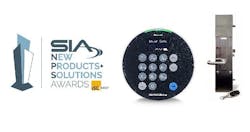10 Years Ago
“Emerging Trends in Access Control” is an annual theme. In 2014, wireless technology and dual credential locks using biometrics were trending, along with implementation of electronic access control on secondary doors. Jerry Levine wrote about window and sliding door locks, looking at the CAL double-bolt lock, the Major Manufacturing Octopod and the Adams Rite 5017 wooden door deadlock. ABUS introduced a plug-and-play video surveillance kit that included a wireless outdoor camera, indoor monitor and an early smartphone app. Ray Zehrung, Marry Hinge, contributed an article on his company’s power transfer products. A problem solver column, “Shhh…Quiet Is a Consideration for Healthcare Facilities,” looked at low-noise door hardware. Gale Johnson helped restore a vintage Eagle pin tumbler lock on an antique church door. Levine also wrote about hospitals converting from mechanical locks to electromechanical locks, using employee identification badges as credentials. The ultimate goal was eliminating the need for medical personnel to carry keys. Tim O’Leary’s article, “Meeting Codes and Safeguarding Patients in a Healthcare Facility” looked at the trend of replacing mechanical door locks with electronic locks. In his article “Selling Home Security,” Johnson warned of the security risks of common keyways that could be duplicated in kiosks and Big Box stores.
20 Years Ago
“Stepping Up to King Cobra” described this early standalone electronic lock as “the next step towards migrating up the security pyramid from a Level 1 patented mechanical key foundation to Level 2 electronic access control.” Another November 2004 article was “Finding Profits in Replacement Keyless Remotes,” still a valid business plan, though the products have certainly advanced. An article on security hardware to keep vandals out looked at hardened collars, drill resistance, latch and cylinder guards and reinforced strike plates. Jerry Levine’s article, “What Is a Forensic Locksmith?” detailed opportunities for locksmiths to testify in court proceedings as subject matter experts. ALOA held its 2004 conference in Baltimore and our November issue contained lots of show photos.
Tools of the Trade from 1940
The 1940 locksmith's toolbox included far more than a file, chisel, hammer and screwdriver. Even then, there were some ingenious tools made to simplify many of the jobs done by locksmiths. One recurring theme concerning locksmiths' tools in the 1940s was that they were primarily mechanically-based. A few examples are shown here.
During the 1930s the H. Hoffman Company was both a distributor and a manufacturer of locksmith tools and supplies. One interesting tool was a lock decoder for Chrysler. Judging from the dates listed on the decoder, it was probably made in 1939 or 1940 just about the time when the first Locksmith Ledger was printed. Chrysler continued using the same lock designs from 1937 to 1948. Keyways were later changed but the same depth and spaces were used on most Chrysler locks until 1968.
HOFFMAN DECODER: The Hoffman decoder held a standard brass auto key in a special jaw. The top shoulder of the blank was trimmed away to allow a spring-actuated probe to fit along the blank. The probe was attached to a large dial indicator. As the blank was inserted into the car lock, the probe would hit the normal shoulder stop of the lock and the dial indicator would show which pin the tip of the key was touching.
The idea was to move the key blade near each pin and then turn the tool slightly so the pin tumbler would not be able to easily enter the top pin chamber. The tip of the key blank was then pressed against the tumbler. The tumbler was forced outward until it touched the cylinder wall. The dial indicator would then show a reading of the pin length and that tumbler space was decoded. After decoding all five spaces, an operating key could be quickly made without lock disassemby.
GM 6-CUT KEY CUTTER: Another automotive tool of note was a neat GM 6-cut key cutter. All you needed to cut keys was this tool, some key blanks and a medium-sized hammer.
GM used one single-sided key blade shape from 1935 to 1966. There were six spaces and four depths. Briggs and Stratton lettered the tumblers C/N/B/Y. "C" was the highest cut and "Y" was the deepest cut. Original tumblers were color-coded: C=copper, N=nickel, B=black and Y=yellow (brass).
Key codes were stamped somewhere on every GM auto lock cylinder. Chevrolet and Buick models had all locks keyed alike while Cadillac, Oldsmobile and Pontiac used Hex-shaped keys working the door and ignition and a round head key working glove and trunk locks. Locksmiths could easily find the four-digit 8000-9499 code stamped on the lock or pawl and determine the key cuts from a code book.
Read the full article at www.locksmithledger.com/10290269.






